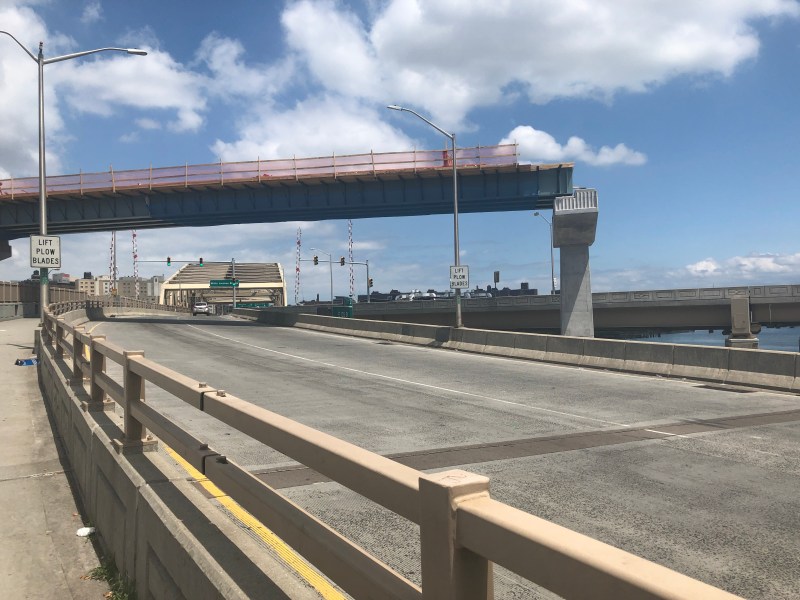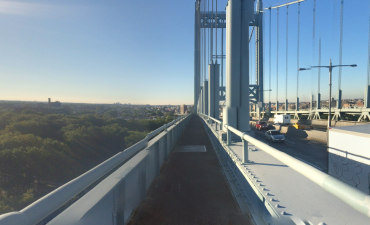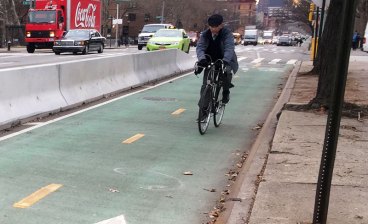OPINION: The Real Reason We Can’t Bike Over MTA Bridges
As its latest project shows, the Robert Moses-founded agency still valorizes motor traffic while ignoring cyclists and pedestrians.

In defiance of regional increases in bicycling and walking, the MTA is again cannibalizing a bridge sidewalk to create another vehicle lane.
In February 2020, MTA Bridges and Tunnels announced construction of a $48 million ramp connecting the Manhattan span of the RFK (Triborough) Bridge to the northbound Harlem River Drive. The diagram of the project shows the new ramp crossing over the span’s northern sidewalk, permanently severing the sidewalk from its Manhattan endpoint.
Although cyclists and pedestrians will still be able to cross the bridge on its southern sidewalk, they’ll have half the space and convenience they had before; there’s also much more likelihood of closures because of construction or emergencies.

This is hardly the first time the Triborough Bridge and Tunnel Authority (the corporate name of MTA Bridges and Tunnels) has done away with sidewalks on its bridges. It’s not even the first time the authority has removed sidewalks from the Triborough Bridge. In fact, the TBTA began narrowing or removing sidewalks upon completing its first bridges in the late 1930s.
The Harlem River Drive ramp project shows the TBTA’s priorities: For $48 million, it will shave around two minutes from the average northbound driver’s trip. In a nod to environmental concerns, the agency claims that the ramp will prevent “2,500 tons of CO2 equivalent emissions,” and that Harlem residents whose streets are clogged with bridge traffic will somehow be safer and breathe easier. Yet these claims don’t compensate for induced demand, a phenomenon by which newly widened roads soon fill with traffic that springs up to take advantage of the temporarily faster route. The TBTA should be intimately familiar with induced demand: It all but invented it in 1939 when it built the Whitestone Bridge and noticed the nearby Triborough Bridge did not see much reduction in traffic.
In recent years, every other regional bridge-building agency added nice things for bicyclists and pedestrians into their major projects. The N.Y. State Thruway Authority’s replacement for the Tappan Zee Bridge included a bicycle/pedestrian path. The Port Authority rebuilt the Goethals Bridge with a 10-foot-wide bike/ped path and has designed substantial sidewalk improvements into the upcoming rehab of the George Washington Bridge. The NY State Department of Transportation’s replacement Kosciuszko Bridge sports a luxurious 20-foot-wide bike/ped path.
Sadly, the TBTA is also the only local agency that prohibits bicycling on bridge sidewalks and harasses bicyclists by ticketing them for not walking their bicycles on the mile-plus trip across the RFK Bridge.
A narrow shared path on the George Washington Bridge. Photo: Neile Weissman
The TBTA claims the five-foot-wide paths on the RFK and Marine Parkway Bridges are too narrow for safe bicycling, and has repeatedly referred to the modern standard of 10 feet width for two-way bike paths. But the RFK Bridge’s two, five-foot paths would have met that standard, if they were signed one-way for bicyclists (and if the TBTA hadn’t removed one of them). Bridges built in the 1930s aren’t expected to meet modern standards — the George Washington Bridge’s sidewalk path is also five feet wide for a hundred yards or so on its Manhattan side, and not much wider the rest of the way. Nonetheless, that path’s peak usage is more than 500 bicyclists and pedestrians an hour, far more traffic than TBTA bridge sidewalks see on most days. Although not ideal, the GWB example proves that compromise is possible if a bridge authority wants to permit bike riding.
Further, the TBTA’s Cross Bay Veterans Memorial Bridge has a 10-foot-wide sidewalk, but bicycling is banned on it, too. It prompts the questions: What causes the TBTA’s dislike of all things not motorized? And why is the agency so resistant to change?
These questions can only be answered by looking back to the formation of the TBTA. As Robert Caro documented in “The Power Broker,” master planner Robert Moses created the TBTA for two main purposes: to build bridges and to create a perpetual money machine, insulated from nearly all forms of oversight, to serve as his personal public-works department and power base. TBTA bridges along with regional highways (also supervised by Moses) enabled the expansion of motor-vehicle dependent, segregated suburban communities and the transportation-based perpetuation of white supremacy.
To start the money machine, the TBTA sold bonds to finance its first bridge, promising to pay the bondholders from toll revenue. Rather than pay off the debt, the TBTA would propose toll-backed projects and borrow even more money. Because state law barred impairing existing contractual obligations (i.e., the toll-backed bonds), debt became a form of power. The more debt the TBTA sold, the more its future was assured as a construction and toll-collecting agency in order to service the debt. The Triborough Bridge, Henry Hudson Bridge, and Whitestone Bridge all wildly exceeded their traffic predictions: Robert Moses had created a fire hose of cash and had no intention of relinquishing it.
Just saw a guy riding his FUCKIN BICYCLE over the Verrazano bridge lmfaooo pic.twitter.com/65RVmM0aKs
— Don Finesse (@stevequigleyYEW) August 12, 2020
This juggernaut was reined in only by some sleight-of-hand by Gov. Nelson Rockefeller and his brother, Chase Bank head David Rockefeller, who in 1968 engineered the takeover of the TBTA by the MTA. The TBTA under the MTA had a new purpose: Surplus toll revenue now would support the subways, buses, LIRR and Metro-North commuter railroads. Without spare cash for big-ticket projects like bridges, the TBTA instead focused on lesser works like maintenance, rehabilitation and shoehorning in new lanes every now and then to make their bridges more attractive to drivers and increase toll revenue.
But bicyclists and pedestrians haven’t paid TBTA tolls since the 1950s. No money, no respect, it seems. Recent TBTA history is full of insults to bicyclists and pedestrians: Sidewalks on the Triborough Bridge were left to rot in the 1980s and 1990s; concrete spalling and temporary metal plates were common. A project around 1991 to expand the Henry Hudson Bridge toll plaza destroyed the Inwood Hill Park path that led to the bridge sidewalk. For the next few years, path users had to clamber around Jersey barriers and decorative plantings. And in 1999, the TBTA’s most heavily used footpath, on the Marine Parkway Bridge that connects bicyclists and pedestrians to Rockaway’s beaches, was closed for construction while the TBTA added a vehicle lane and relocated and rebuilt the sidewalk — to the same narrow width as the original, bicycling still prohibited.
In 2004, the TBTA closed one of the two sidewalks on the Triborough Bridge’s Queens span in order to cannibalize it for traffic lanes. Major capital projects on the Verrazano and Henry Hudson Bridges that could have included bicycle/pedestrian improvements shut them out instead. The TBTA has conducted two studies on adding a path to the Verrazano, but it refuses to release the second study to the public, much less act on it.
Experience shows that only the governor and Legislature have any major influence on the TBTA. Improving bike/ped access to TBTA bridges will require grassroots effort to persuade the politicians who can change the TBTA’s priorities. Meanwhile, on TBTA bridges, money talks — and bicyclists walk. Assuming there are any sidewalks still left to walk on.
Ed Ravin (@VeloTraveler), a long-time bicycling and livable-streets advocate, is a past board member of the Five Borough Bicycle Club and Transportation Alternatives.



